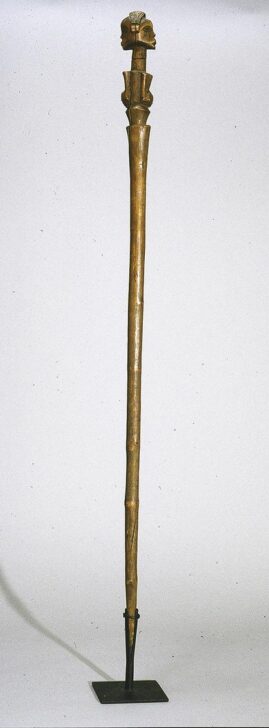Staff
Nsapo

Description
Subject Matter:
Among the Nsapo, a Luba sub-group from the Democratic Republic of the Congo, carved staffs with figurative finials were the prerogative of chiefs. Known as kibango amongst the Luba, a chief's staff was much more than a walking stick; it communicated his identity, status, and power through nuanced messages conveyed in its iconography.
The finial of this chief’s staff features janiform carvings which convey myriad meanings. There are two opposing female figures, both of whom rest their hands upon their pregnant, protruding bellies. This pair of women represents revered, maternal ancestors whose help the chief seeks for the welfare of the clan. Their depictions serve as a visual and tactile reminder that they continue to protect their descendants from the afterlife as they once did while alive. Moreover, the two faces symbolize dualities and oppositions: the past and the future, the visible and the invisible, life and death, and the earthly realm and the spiritual realm. Taken together, they possess the quality of omniscience.
A chief communicated his royal lineage through the carvings of particular female ancestors on his staff. In the royal court and beyond, this link with an ancestral past legitimizes and protects the chief’s claim to political authority. Furthermore, the maternal ancestors symbolize fertility, maternity, progeny, and, above all, the continuation of the lineage — a primary concern of the chief and his clan.
Reference:
Staffs of Life: Rods, Staffs Scepters and Wands from the Coudron Collection of African Art. Ed.: Allen F. Roberts. Iowa City: PASALA: The Project for Advanced Study of Art and Life in Africa and the University of Iowa Museum of Art, 1994.
Physical Description:
This carved, wooden staff features an anthropomorphic, janiform finial, a smooth midsection, and a spiked base. The two opposing figures are a pair of pregnant women, both of whom have their hands placed upon their protruding bellies. Their facial features share a close resemblance to one another: they have small eyes set in almond-shaped ocular cavities, finely-detailed coiffures, and vertical lines running down their cheeks.
Usage Rights:
If you are interested in using an image for a publication, please visit https://umma.umich.edu/request-image/ for more information and to fill out the online Image Rights and Reproductions Request Form.